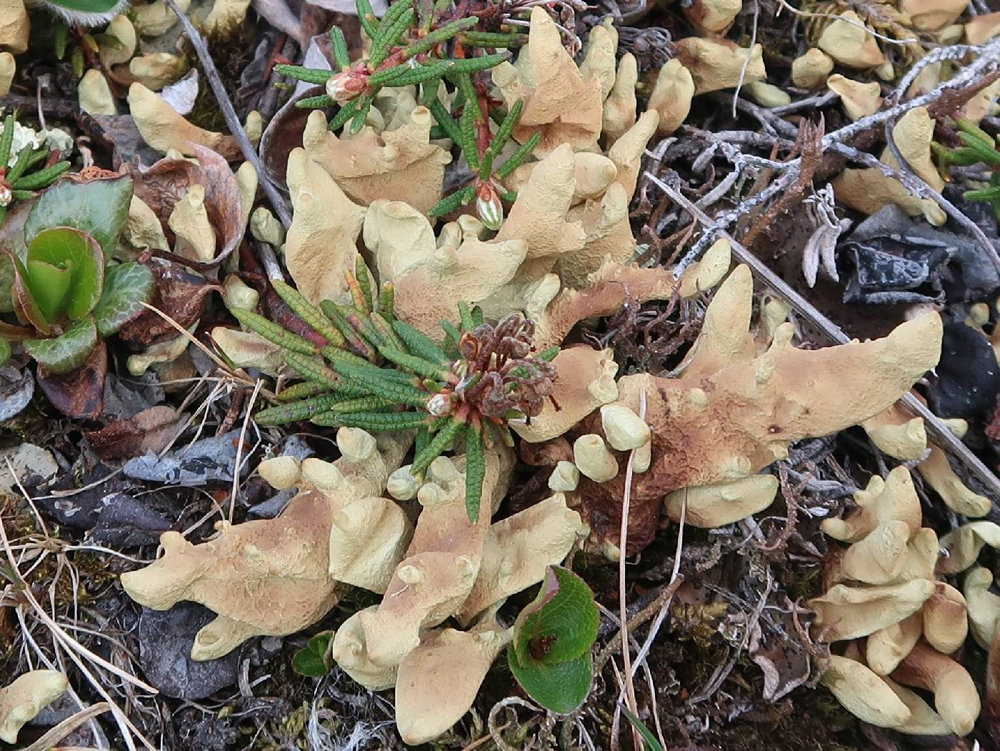 by Troy McMullin by Troy McMullin
Lichens are extremely habitat specific. They are sensitive to the type of tree they grow on, the age of the tree, the level of moisture in the air, the available nutrients; even air quality is a critical factor. These organisms provide strong clues to a deeper understanding and appreciation of our natural world.
Coral reefs and lichens have much in common. They both have spectacular variations in colours, sizes and shapes. Their nutrients are obtained from what is drifting by; for lichens, it is from the atmosphere and precipitation. They are both sensitive to disturbances, and they are actually multiple organisms working together.
The main body of a lichen is fungus. Inside the fungus is a layer of green algae which produce carbohydrates from photosynthesis. Sometimes cyanobacteria, which used to be called/classified as a blue-green algae, take the place of the algae or, in rare cases, all three organisms coexist.
Cyanobacteria have the ability to fix atmospheric nitrogen. In other words, they capture nitrogen from the air and embed it into an organic molecule, thereby making this nitrogen available to the fungus and it can then be transferred to the soil where it can be used by other life forms. This is particularly important in nitrogen-poor regions such as the Arctic.
The fungus transforms into something of a greenhouse with the cyanobacteria and/or algae living inside it. The cyanobacteria and algae feed the fungus and the fungus in turn provides shelter and protection to these organisms.
Because of this integrated relationship, they do not need soil. In fact, lichens are the pioneers of forest succession. They can colonize bare rock and start the process that eventually leads to an old-growth forest. This is only possible because they obtain their nutrients directly from the air and water that washes over them and their energy is from the sun.
 The ability of lichens to eat air causes a sensitivity to air quality. If pollutants are in the air, they are taken in by lichens as well. While certain lichens cannot tolerate polluted air, others are much more tolerant. Some lichens thrive in cities where there is lots of automobile exhaust; others can only survive where the air is cleaner. Lichens are also particularly good at inhabiting extreme environments, such as the tundra. They are one of the most abundant life forms in the Arctic. The ability of lichens to eat air causes a sensitivity to air quality. If pollutants are in the air, they are taken in by lichens as well. While certain lichens cannot tolerate polluted air, others are much more tolerant. Some lichens thrive in cities where there is lots of automobile exhaust; others can only survive where the air is cleaner. Lichens are also particularly good at inhabiting extreme environments, such as the tundra. They are one of the most abundant life forms in the Arctic.
In terms of classification, the type of fungus always determines the lichen species. This is because the same species of algae or cyanobacteria can be present in different lichens. Infrequently, there is also a yeast coexisting with the fungus. The interesting thing about these composite organisms is that they transform their shape and function from what they normally look like and do, compared to when they live alone.
Lichens play an important role in erosion control as they have the ability to bind soil and lock it down. They are also used as nesting material, by such animals and birds as flying squirrels and hummingbirds. They are also an important food source for a wide range of organisms, particularly caribou and insects, and they act as an important camouflage, as many insects look like lichen.
In summary, it is a marvel at how these organisms thrive in such diverse habitats. One thing is certain, they tell us a great deal about the ecosystem in which they grow. Their ability to work together is simply amazing. From an environmental perspective, we can use lichens to help make informed conservation decisions that allow long-term planning around protected areas.
Photo credit: All lichen photos throughout this calendar were contributed by Troy McMullin.
|


![]()

 by Troy McMullin
by Troy McMullin The ability of lichens to eat air causes a sensitivity to air quality. If pollutants are in the air, they are taken in by lichens as well. While certain lichens cannot tolerate polluted air, others are much more tolerant. Some lichens thrive in cities where there is lots of automobile exhaust; others can only survive where the air is cleaner. Lichens are also particularly good at inhabiting extreme environments, such as the tundra. They are one of the most abundant life forms in the Arctic.
The ability of lichens to eat air causes a sensitivity to air quality. If pollutants are in the air, they are taken in by lichens as well. While certain lichens cannot tolerate polluted air, others are much more tolerant. Some lichens thrive in cities where there is lots of automobile exhaust; others can only survive where the air is cleaner. Lichens are also particularly good at inhabiting extreme environments, such as the tundra. They are one of the most abundant life forms in the Arctic.